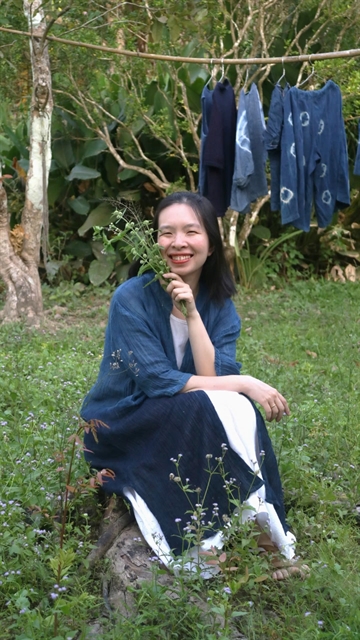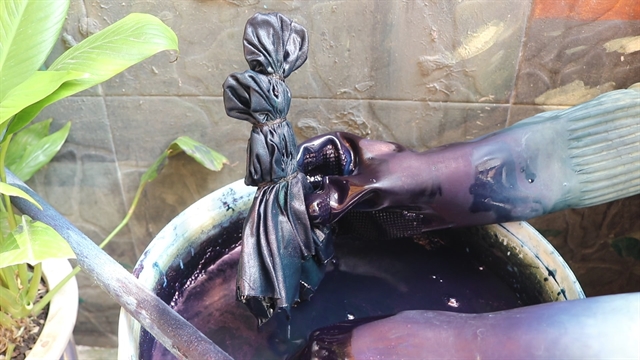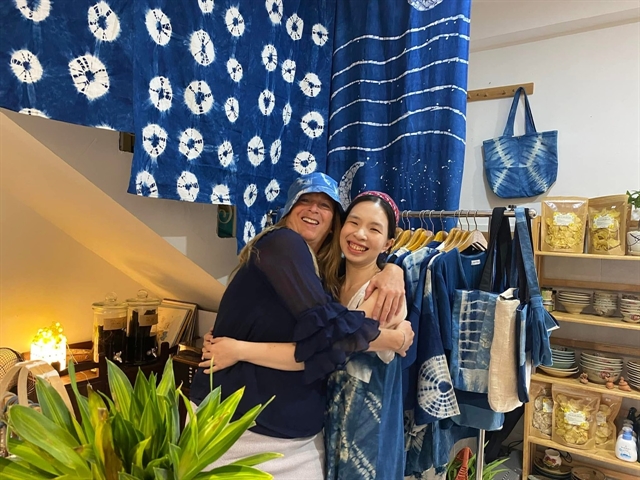Weather:
- Ha Noi 29oC
- Da Nang 25oC
- Ho Chi Minh 35oC
Saigon Indigo has been making hand-dyed indigo products for the last two years, and seeks to help preserve this traditional craft of the Mông people. Its founder and owner, Đỗ Bích Phương, speaks to Việt Nam News about her journey.

Inner Sanctum: Could you tell us about yourself and your work?
I am Đỗ Bích Phương of HCM City. I am the founder and owner of Saigon Indigo, a hand-dyed clothing brand, and Lá Dứa (Pandan Leaves) Arts and Craft Gift Shop. I have been making indigo-dyed products for nearly seven years.
I have been into fashion since young, but back then living in the city made me think of fashion as something fast-paced and industrial. I spent a lot of time searching for something that really suits me, and eventually knew about natural dyeing, specifically indigo dyeing.
Inner Sanctum: What is the story behind your brand Saigon Indigo?
I learnt about indigo dyeing in 2015. I had a business making essential oils in Sapa Town in the northern province of Lào Cai, and I stayed at Cát Cát Village with ethnic Mông women. Indigo dyeing has long been a tradition of the Mông, and it is one of their daily activities. I really like the techniques and meticulousness behind the craft.
Indigo dyeing is close to nature, which really suits me. It does not need to follow trends, so it is also a sustainable way to do fashion. My interest in fashion and the will to pursue this craft nudged me forward, so I started learning it and created a fan page for Saigon Indigo in 2018.
But then the pandemic hit, and I postponed my plan by three years. The middle of 2022 was when I took things seriously and turned Saigon Indigo into a business.
Inner Sanctum: What are the differences between indigo dyeing and industrial dyeing?
Indigo dyeing has been a traditional craft around the world for thousands of years. In Việt Nam, the Mông people are among the few to use this method to make their garments.
The craft involves natural or organic dyeing, with only natural ingredients being used. The Mông grow the indigo plants themselves, and even the fabrics they use are made from natural fibres. This makes indigo dyeing more environmentally friendly and sustainable compared to other methods.
Another plus point is that the dyeing techniques prevent the colour from bleeding.
Inner Sanctum: Saigon Indigo products are 100 per cent handmade. Can you explain for the readers how the dyeing process works?
The process starts with making the dye. An indigo dye is a mixture of indigo paste, lye water and white liquor in a precise ratio. I usually make a batch of 20 to 30 litres at a time. The dye is then left at room temperature to ferment. The fermentation can take from a few days to weeks depending on the weather and humidity. Once the fermentation is done, it is ready.

Saigon Indigo uses various types of fabrics, which can be divided into two groups: natural and industrial. For the former, I like to use hemp fabric, or gai dầu in Vietnamese. I usually buy it in Sa Pa. The Mông people there grow the plants, make the fibre, and weave the fabric themselves. For industrial fabrics, I prefer linen, cotton and muslin. I choose these fabrics because they are made of natural fibres and so are durable and sustainable, and take up the dye colour really well.
The patterns are all handmade. I refer to many traditional techniques and use things I find around me. Sometimes I use rubber bands to tie knots around a piece of fabric, sometimes I sew and tie the fabric in layers. I also use leaves and branches. Another great way is to collect spare pieces of fabric and quilt them together. I can be as creative as I want.
After choosing the fabric and making the patterns, I start dyeing. Whether the colour is light or dark depends on the number of times I dip the fabric into the dye. Each time a fabric is dipped, dried partially, washed under water, and dipped into the dye again. The process is repeated until I reach the desired shade.
Doing this teaches me how to be patient and careful. It also allows me to be creative and freely design fashion items in my own style.
Inner Sanctum: What are the difficulties you face in this craft?
The most challenging thing is to preserve the dye from getting spoilt since it contains all natural ingredients and no preservatives. If this happens, it stalls the entire process and reduces the quality of the products.
Finding the ingredients is another challenge. The main element of the dye, indigo paste, can be found only in Sa Pa in Lào Cai and other provinces in the northwest of the country. Thus, when there are bulk orders, it is hard for me to find a large supply of ingredients.
This craft requires me to learn and explore new things every day, and I am happy about that.
Inner Sanctum: Since this craft is not known to a lot of people, what do customers say when they first see your products?
Many Vietnamese customers do not know much about organic dyeing or indigo dyeing at first. They are very surprised to know that there are still people doing organic and hand dyeing these days. As for foreign customers, most really prefer hand crafted items, and so they adore them.

Inner Sanctum: What is the impact you want to make through your craft, and what are your future plans?
I want to broaden Saigon Indigo further so that more people know about organic dyeing and support the craft and craftspeople.
I am holding workshops for young people and school children. I hope I can somehow inspire the young to start researching and become more engaged in not only organic dyeing but also other crafts as well so that the Vietnamese hand dye and craft communities can grow holistically.
I believe our communities will help preserve and innovate such traditional crafts in the country. VNS


